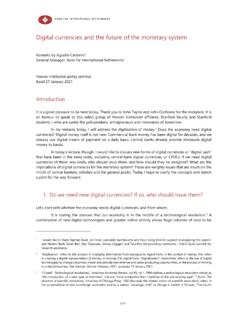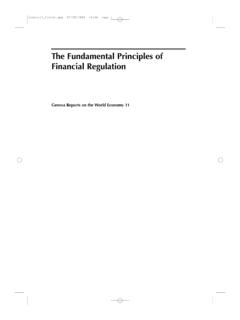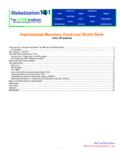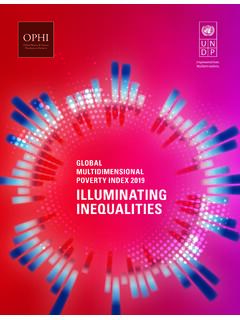Transcription of BIS Working Papers
1 BIS Working Papers No 983 Losing traction? The real effects of monetary policy when interest rates are low by Rashad Ahmed, Claudio Borio, Piti Disyatat and Boris Hofmann monetary and Economic Department November 2021 JEL classification: E20, E52, E58. Keywords: monetary policy, low interest rates, monetary transmission mechanism. BIS Working Papers are written by members of the monetary and Economic Department of the Bank for international Settlements, and from time to time by other economists, and are published by the Bank.
2 The Papers are on subjects of topical interest and are technical in character. The views expressed in them are those of their authors and not necessarily the views of the BIS. This publication is available on the BIS website ( ). Bank for international Settlements 2021. All rights reserved. Brief excerpts may be reproduced or translated provided the source is stated. ISSN 1020-0959 (print) ISSN 1682-7678 (online) WP 983: Losing traction? The real effects of monetary policy when interest rates are low i Losing traction? The real effects of monetary policy when interest rates are low Rashad Ahmed, Claudio Borio, Piti Disyatat, Boris Hofmann November 2021 Abstract Are there limits to how far reductions in interest rates can boost aggregate demand?
3 In particular, as interest rates fall to very low levels, does the effectiveness of monetary policy in boosting the economy wane? We provide evidence consistent with this hypothesis. Based on a panel of 18 advanced countries starting in 1985, we find that monetary transmission to economic activity is substantially weaker when interest rates are low. The results hold even when controlling for potential confounding non-linearities associated with debt levels and the business cycle as well as for the trend decline in equilibrium interest rates. We also find evidence that the effectiveness of monetary policy wanes the longer interest rates stay low.
4 These findings suggest that the observed flattening of the Phillips curve has gone hand in hand with a corresponding steepening of the IS curve. monetary policy trade-offs may have become more challenging. JEL classification: E20, E52, E58. Keywords: monetary policy, low interest rates, monetary transmission mechanism. We would like to thank Beno t Mojon, Daniel Reese and Egon Zakraj ek as well as participants at an internal BIS seminar and a joint BIS-SNB research workshop for helpful comments and discussions. Adam Cap, Murphy Pan and Taejin Park provided excellent statistical assistance.
5 All remaining errors are ours. The views expressed are those of the authors and do not necessarily represent those of the Bank for international Settlements or the US Department of the Treasury. Hofmann (corresponding author): Research Adviser, Bank for international Settlements; Ahmed: Office of the Comptroller of the Currency, US Department of the Treasury, Borio: Head of monetary and Economic Department, Bank for international Settlements, Disyatat: Bank of Thailand, WP 983: Losing traction?
6 The real effects of monetary policy when interest rates are low iii Table of contents Introduction .. 1 1. Data .. 4 2. Empirical approach .. 5 3. Results .. 7 Linear case .. 7 Regime-dependent monetary transmission .. 8 Horse races .. 9 4. Robustness .. 13 Robustness checks .. 13 Robustness results .. 14 5. Low for long .. 16 6. High-frequency monetary policy shocks .. 19 Conclusions .. 20 References .. 22 Appendix A: Data sources .. 25 Appendix B: Interest rate, output and debt regimes .. 26 WP 983: Losing traction? The real effects of monetary policy when interest rates are low 1 Introduction Interest rates in many countries, particularly in the core advanced economies, have been persistently low for more than a decade now.
7 In some jurisdictions, policy rates have even been in negative territory for several years. Yet, despite these very low rates and aggressive monetary policy easing, the strength of the economy has been, on balance, disappointing since the Great Financial Crisis (GFC). In major advanced economies, post-GFC real GDP has trailed well below its extrapolated pre-GFC trajectory, following a flatter trend (Graph 1). At the same time, inflation has tended to languish below target, at least until the post-Covid major fiscal policy expansion.
8 Is it possible that the effectiveness of monetary policy in boosting the economy has waned? This question is not new and has prompted some possible answers. Much of the discussion of the potentially diminished traction of monetary policy has focused on the reduced policy space as a result of a fall in the equilibrium real rate of interest (eg Gust et al (2017), Hofmann et al (2021)). If equilibrium interest rates are now lower, low interest rates would provide a smaller degree of monetary accommodation. Another focal point of the debate has been a smaller impact of monetary policy on inflation due to a flattening of the Phillips curve (eg Stock and Watson (2019), Del Negro et al (2020)).
9 If price dynamics are less responsive to economic slack, monetary policy may need to push harder to achieve inflation goals. But it is also possible that aggregate demand itself has become less responsive to monetary policy. In other words, the IS curve may have steepened a hypothesis laid out by Borio and Hofmann (2017). There are many potential explanations, not least headwinds linked to the need to work off the post-GFC debt overhang. A more troubling possibility, though, is that the low interest rate environment itself may be partly In that case, the weakness would be a more endemic and harder 1 See, for example, Schnabel (2020).
10 Real GDP1 Quarterly data, in billions of respective currency units Graph 1 United States Euro area United Kingdom 1 Seasonally adjusted, on a logarithmic scale. Sources: National data; BIS calculations. 5,5005,0004,5004,0003,5003,0002019201420 092004 Actual3,2003,0002,8002,6002,4002,2002019 2014200920042001 07 extrapolated trend65060055050045040020192014200920042 009 19 trend2 WP 983: Losing traction? The real effects of monetary policy when interest rates are low to overcome. The harder the central bank tries to generate monetary stimulus, the more difficult it becomes.













